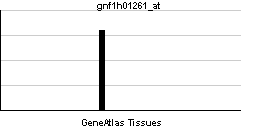DCD (gene)
Jump to navigation
Jump to search
| Dermcidin | |||||||||||
|---|---|---|---|---|---|---|---|---|---|---|---|
| Identifiers | |||||||||||
| Symbols | DCD ; HCAP; AIDD; DCD-1; DSEP; MGC71930; PIF | ||||||||||
| External IDs | Template:OMIM5 HomoloGene: 89039 | ||||||||||
| |||||||||||
| RNA expression pattern | |||||||||||
 | |||||||||||
| More reference expression data | |||||||||||
| Orthologs | |||||||||||
| Template:GNF Ortholog box | |||||||||||
| Species | Human | Mouse | |||||||||
| Entrez | n/a | n/a | |||||||||
| Ensembl | n/a | n/a | |||||||||
| UniProt | n/a | n/a | |||||||||
| RefSeq (mRNA) | n/a | n/a | |||||||||
| RefSeq (protein) | n/a | n/a | |||||||||
| Location (UCSC) | n/a | n/a | |||||||||
| PubMed search | n/a | n/a | |||||||||
Dermcidin, also known as DCD, is a human gene.[1]
This gene encodes a secreted protein that is subsequently processed into mature peptides of distinct biological activities. The C-terminal peptide is constitutively expressed in sweat and has antibacterial and antifungal activities. The N-terminal peptide, also known as diffusible survival evasion peptide, promotes neural cell survival under conditions of severe oxidative stress. A glycosylated form of the N-terminal peptide may be associated with cachexia (muscle wasting) in cancer patients.[1]
References
Further reading
- Todorov P, Cariuk P, McDevitt T; et al. (1996). "Characterization of a cancer cachectic factor". Nature. 379 (6567): 739–42. doi:10.1038/379739a0. PMID 8602222.
- Todorov PT, Deacon M, Tisdale MJ (1997). "Structural analysis of a tumor-produced sulfated glycoprotein capable of initiating muscle protein degradation". J. Biol. Chem. 272 (19): 12279–88. PMID 9139670.
- Cunningham TJ, Hodge L, Speicher D; et al. (1998). "Identification of a survival-promoting peptide in medium conditioned by oxidatively stressed cell lines of nervous system origin". J. Neurosci. 18 (18): 7047–60. PMID 9736629.
- Cunningham TJ, Jing H, Wang Y, Hodge L (2000). "Calreticulin binding and other biological activities of survival peptide Y-P30 including effects of systemic treatment of rats". Exp. Neurol. 163 (2): 457–68. doi:10.1006/exnr.2000.7390. PMID 10833321.
- Schittek B, Hipfel R, Sauer B; et al. (2001). "Dermcidin: a novel human antibiotic peptide secreted by sweat glands". Nat. Immunol. 2 (12): 1133–7. doi:10.1038/ni732. PMID 11694882.
- Cunningham TJ, Jing H, Akerblom I; et al. (2002). "Identification of the human cDNA for new survival/evasion peptide (DSEP): studies in vitro and in vivo of overexpression by neural cells". Exp. Neurol. 177 (1): 32–9. PMID 12429208.
- Strausberg RL, Feingold EA, Grouse LH; et al. (2003). "Generation and initial analysis of more than 15,000 full-length human and mouse cDNA sequences". Proc. Natl. Acad. Sci. U.S.A. 99 (26): 16899–903. doi:10.1073/pnas.242603899. PMID 12477932.
- Porter D, Weremowicz S, Chin K; et al. (2003). "A neural survival factor is a candidate oncogene in breast cancer". Proc. Natl. Acad. Sci. U.S.A. 100 (19): 10931–6. doi:10.1073/pnas.1932980100. PMID 12953101.
- Zhang Z, Henzel WJ (2005). "Signal peptide prediction based on analysis of experimentally verified cleavage sites". Protein Sci. 13 (10): 2819–24. doi:10.1110/ps.04682504. PMID 15340161.
- Suzuki Y, Yamashita R, Shirota M; et al. (2004). "Sequence comparison of human and mouse genes reveals a homologous block structure in the promoter regions". Genome Res. 14 (9): 1711–8. doi:10.1101/gr.2435604. PMID 15342556.
- Monitto CL, Dong SM, Jen J, Sidransky D (2005). "Characterization of a human homologue of proteolysis-inducing factor and its role in cancer cachexia". Clin. Cancer Res. 10 (17): 5862–9. doi:10.1158/1078-0432.CCR-04-0435. PMID 15355918.
- Gerhard DS, Wagner L, Feingold EA; et al. (2004). "The status, quality, and expansion of the NIH full-length cDNA project: the Mammalian Gene Collection (MGC)". Genome Res. 14 (10B): 2121–7. doi:10.1101/gr.2596504. PMID 15489334.
- Lai YP, Peng YF, Zuo Y; et al. (2005). "Functional and structural characterization of recombinant dermcidin-1L, a human antimicrobial peptide". Biochem. Biophys. Res. Commun. 328 (1): 243–50. doi:10.1016/j.bbrc.2004.12.143. PMID 15670776.
- Rieg S, Steffen H, Seeber S; et al. (2005). "Deficiency of dermcidin-derived antimicrobial peptides in sweat of patients with atopic dermatitis correlates with an impaired innate defense of human skin in vivo". J. Immunol. 174 (12): 8003–10. PMID 15944307.
- Watchorn TM, Dowidar N, Dejong CH; et al. (2006). "The cachectic mediator proteolysis inducing factor activates NF-kappaB and STAT3 in human Kupffer cells and monocytes". Int. J. Oncol. 27 (4): 1105–11. PMID 16142329.
- Baechle D, Flad T, Cansier A; et al. (2006). "Cathepsin D is present in human eccrine sweat and involved in the postsecretory processing of the antimicrobial peptide DCD-1L". J. Biol. Chem. 281 (9): 5406–15. doi:10.1074/jbc.M504670200. PMID 16354654.
- Lowrie AG, Wigmore SJ, Wright DJ; et al. (2006). "Dermcidin expression in hepatic cells improves survival without N-glycosylation, but requires asparagine residues". Br. J. Cancer. 94 (11): 1663–71. doi:10.1038/sj.bjc.6603148. PMID 16685272.
- Ewing RM, Chu P, Elisma F; et al. (2007). "Large-scale mapping of human protein-protein interactions by mass spectrometry". Mol. Syst. Biol. 3: 89. doi:10.1038/msb4100134. PMID 17353931.
- Frum R, Busby SA, Ramamoorthy M; et al. (2007). "HDM2-binding partners: interaction with translation elongation factor EF1alpha". J. Proteome Res. 6 (4): 1410–7. doi:10.1021/pr060584p. PMID 17373842.
- Lee Motoyama JP, Kim-Motoyama H, Kim P; et al. (2007). "Identification of dermcidin in human gestational tissue and characterization of its proteolytic activity". Biochem. Biophys. Res. Commun. 357 (4): 828–33. doi:10.1016/j.bbrc.2007.03.112. PMID 17448443.
| This protein-related article is a stub. You can help Wikipedia by expanding it. |